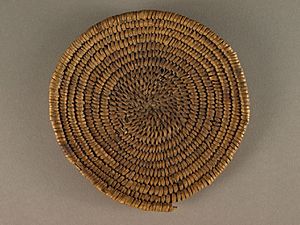Early Basketmaker II Era facts for kids
The Early Basketmaker II Era (1500 BCE – 50 CE) was an important time for the Ancient Pueblo People. It was the first period after the Archaic era. This period began when people started growing maize (corn) in the northern American Southwest. However, they didn't fully depend on farming until about 500 BCE. This era came after the Archaic–Early Basketmaker Era and was followed by the Late Basketmaker II Era.
Contents
Who Were the Early Basketmakers?
The people known as Basketmakers were not just one group. They were likely a mix of people who moved from the south and local groups who learned to farm. For example, people in New Mexico were already growing corn. They had also started living in one place more often before the Early Basketmakers.
There were similarities between the Basketmakers II and the Cochise tradition. These included special arrowheads and a unique basket style. This basket style was called "two rod and bundle."
To become a Basketmaker, people learned to grow corn. They also started living in pit-houses instead of moving around all the time. Other changes included new ways of making baskets. They also used different symbols in their rock art and had new burial customs. They also traded more items with other groups.
Life as Hunter-Gatherers
For most of this period, the Early Basketmakers were nomadic hunter-gatherers. This means they moved around a lot. They traveled across the Colorado Plateau in small groups. They gathered wild plants that were ready to eat. They also hunted animals for food.
Moving around also helped them meet other tribes. They would socialize, trade goods, and sometimes even marry people from other groups. Growing corn slowly changed their nomadic lifestyle.
How Did Farming Change Their Lives?
Maize and squash were first grown in Mexico over 8,700 years ago. These crops were found on the Colorado Plateau between 1000 and 2000 BCE. By 500 BCE, corn was a regular crop. It became a main part of the Basketmakers' diet.
Growing corn gave the Basketmakers more control over their food. They could grow what they needed. They also stored extra ground corn for later. At first, farming did not stop them from moving. After planting seeds, they still roamed to hunt and gather wild foods. They would return to their crops when they were ready to harvest. This was similar to how they followed wild plant cycles, like for pinyon nuts.
However, when they were away, deer, birds, and rodents would eat their crops. This meant the Basketmakers had to stay near their fields. They protected their crops until harvest time. After harvesting, they made storage pits. These pits kept seeds for next year's crops safe. They also protected extra food from insects and rodents. The pits were lined with stone and bark. They were then sealed tightly with adobe mud.
Where Did They Live?
The Early Basketmakers lived in caves and other shelters. Many of these shelters were built underground. They were often lined with stone.
One of the earliest pit-houses was found in southwestern Colorado. It dates back to 405–75 BCE. This pit-house is on Sleeping Ute Mountain. It had a fireplace for cold weather. But there was no sign that food was grown there. This site might show how people started to farm. It was a permanent or semi-permanent home.
What Did They Make and Use?
Basketry
The Basketmakers used a special method to make baskets. It was called the "two-rod and bundle" technique. They used thin, flexible twigs and yucca plant fibers. These bundles were coiled into a spiral shape. Then they were sewn together with thin strips of yucca leaves. This method was used from about AD/CE.
Baskets were very useful. They were used to gather food, store it, and even cook. People were still somewhat nomadic when these baskets were made.
Personal Items
The Early Basketmakers had several important personal items. These included:
- weapons for hunting
- clothing
- baskets for daily tasks
Other Ancient Groups and Places
The Early Basketmaker II Era was part of a larger time in the Southwest. Other cultural groups lived during this period. They included:
- Ancestral Puebloans – found in southern Utah, southern Colorado, northern Arizona, and northern and central New Mexico
- Hohokam – lived in southern Arizona
- Mogollon – found in southeastern Arizona, southern New Mexico, and northern Mexico
- Patayan – lived in western Arizona, California, and Baja California
Important Sites from This Time
Some notable places where Early Basketmaker II history can be found include:
- Petrified Forest National Park – Arizona
- Sleeping Ute Mountain – Colorado
- Virgin Anasazi – in the Colorado Plateau of Nevada, Utah, and Arizona
- Zion National Park – Utah




